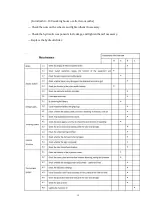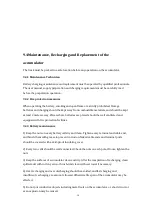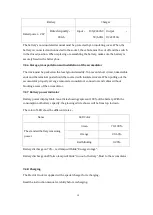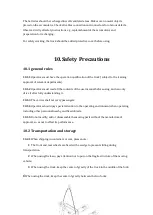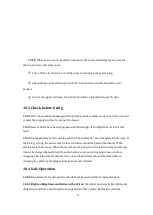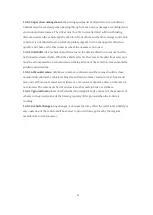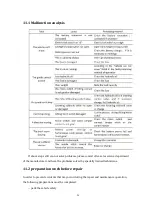
17
6) Never spill any hazardous liquid or solid material on surfaces of the accumulator. When
using a densimeter or a thermometer, make sure the surface is clean and clear.
7) Recharge the discharged accumulator in time. Delayed recharging may damage the
accumulator. Do not delay recharging more than 24 hours. Recharging of the accumulator
may not work outdoors in cold weather. In this case, move it indoors to perform recharging.
8) If the accumulator will not be in use for a long time, it should be recharged and discharged
once every month and it should be fully recharged every time.
9) During recharging or using, the liquid level of electrolyte lowers because of water
evaporation, so pure water should be added. It is not allowed to add electrolyte with a
specific weight of 1.280.
10) If individual cell fails, identify the cause and repair the cell immediately. Replace the cell
when it cannot be repaired.
11) The site for recharging should be well ventilated. It is prohibited to smoke or use open
fire, avoiding the risk of hydrogen explosion.
12) The electrolyte in accumulator is toxic and corrosive. For this reason, always wear
working suit and protection glasses to protect your body from contacting the electrolyte in
accumulator.
13) If your clothes, skin or eyes are spilled with acid liquid in accumulator, flush with large
amount of clean water. For skin and eyes, flush with large amount of clean water and also
seek doctor’s treatment immediately. Acid spillage must be neutralized and treated
immediately.
14) The weight and dimensions of the accumulator have remarkable effect on stability of the
stacker. Therefore do not modify the type of accumulator without approval from the
manufacturer.
15) Never discharge in large current, for example, performs travelling and lifting
simultaneously.
9.4.4 Disposition of worn-out accumulators
Worn-out accumulators should be recycled according to local regulations, and stored in
specified zone or cast-off treatment zone. These works should be done by qualified
specialized companies.
9.4.5 Specification of the battery
Summary of Contents for EP18D Series
Page 13: ...10 7 Hydraulic Schematic Diagram...
Page 26: ...23 11 Repair Manual...













